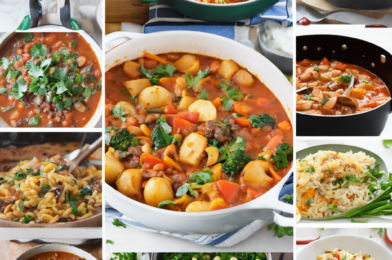Meal prep is a fantastic way to streamline your cooking, save time, and ensure you’re eating healthy, nutritious meals. It can be a game-changer for busy individuals and families, helping to reduce the stress of daily cooking and decision-making around meals. This beginner’s guide will take you through the steps to get started and set you up for success.
Plan and Prepare:
Begin by assessing your weekly schedule and deciding how many meals you want to prep. A good rule of thumb is to focus on the types of meals you find most challenging to cook from scratch on busy days. For many, that’s lunch and dinner, but it could also include breakfast or even snacks. Once you’ve identified your target meals, choose recipes with ingredients that can be used in multiple dishes. This will reduce food waste and save you money. Make a detailed grocery list and shop for fresh, whole foods that excite you.
Master the Art of Batch Cooking:
Batch cooking is a meal prep staple. It involves cooking large portions of base ingredients that can be used in multiple meals. Cook a big batch of grains like rice or quinoa, roast trays of your favorite vegetables, and prepare a few types of proteins. You can also make a large pot of soup or stew, which can be frozen in portions and easily reheated. This method saves time and ensures you have a variety of nutritious foods ready to go.
Organize and Store:
Invest in good-quality meal prep containers that are leak-proof, durable, and preferably glass or BPA-free plastic. Proper storage will keep your food fresh and tasty. Label and date your containers, and be mindful of food safety practices. Store your prepped meals in the fridge or freezer, depending on when you plan to eat them. Aim for a balanced plate by including a combination of proteins, carbohydrates, and lots of vegetables in each meal.
Create a Meal Prep Routine:
Choose a day or two each week that works best for your schedule to dedicate a few hours to meal prep. It might be a quiet Sunday afternoon or perhaps a weeknight after work. Having a consistent routine will help you stay organized and make meal prep a habit. Eventually, it will become second nature, and you’ll reap the benefits of healthy, homemade meals with minimal daily effort.
Variations and Customization:
The beauty of meal prep is that it can be customized to your tastes and dietary needs. If you’re cooking for a family, involve them in the process by asking for their input on favorite meals and ingredients. This is also a great opportunity to expose children to healthy eating habits and involve them in the kitchen. By preparing meals in advance, you can control the ingredients, portion sizes, and nutritional content, catering to any specific dietary requirements or allergies.
Benefits of Meal Prep:
Meal prep offers numerous advantages beyond convenience. It encourages healthier eating habits by reducing the temptation to order takeout or resort to less nutritious options. Meal prep also saves you money by cutting down on food waste and impulse purchases. With a little planning, you’ll find yourself throwing away less food and making more conscious choices about what you buy and eat. Additionally, meal prep helps streamline your week, reducing the daily burden of deciding what to eat and cook.
Tips for Success:
Start small and simple. Choose a few meals or ingredients to prep, and gradually increase as you get comfortable. Look for meal prep inspiration online or in cookbooks, and don’t be afraid to experiment and adapt recipes to your taste. Invest in the right tools, like good knives and chopping boards, to make the process easier and more enjoyable. Finally, be mindful of food safety. Properly store and label your meals, and follow basic hygiene practices to ensure your food stays fresh and safe to eat.
Meal prep is an incredible tool to help you eat well and save time. By planning, batch cooking, and organizing your meals, you’ll soon enjoy the benefits of nutritious, delicious food with minimal daily effort. Happy prepping!

